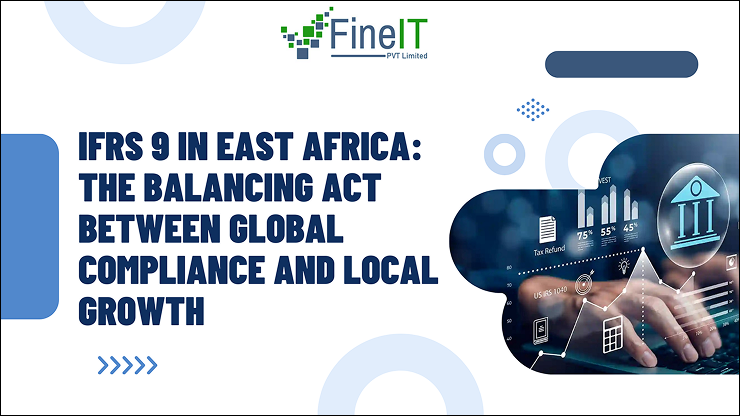Accounting standards rarely stir public debate, but in the dynamic banking sectors of East Africa, one regulation – IFRS 9 Financial Instruments – has emerged as a silent, yet powerful, force. Replacing the older “incurred loss” model, IFRS 9 mandates a forward-looking approach to credit provisioning, requiring banks to anticipate potential losses rather than reacting to them. While this global compliance initiative promises enhanced financial stability, it introduces a complex balancing act, particularly for East Africa’s crucial Small and Medium-sized Enterprises (SMEs). Is the pursuit of global best practices inadvertently slowing down the engine of local economic growth?
The Paradigm Shift: From “Too Little, Too Late” to Expected Credit Loss (ECL)
To understand the impact of IFRS 9, it’s essential to grasp its core change. Historically, under IAS 39, banks would only set aside money for loan losses once objective evidence of impairment (like a missed payment) had occurred. This “incurred loss” model was criticized for being “too little, too late,” especially during economic downturns when losses could accumulate rapidly before provisions were made.
IFRS 9 introduces the Expected Credit Loss (ECL) model, a significant paradigm shift. Under ECL, banks must provision for potential losses from the moment a loan is originated, based on a comprehensive assessment of future economic conditions and the borrower’s creditworthiness. This means provisioning for expected losses over the entire lifetime of a financial instrument, not just when defaults occur. This forward-looking approach aims to make banks more resilient and better prepared for financial shocks.
IFRS 9’s Dual Impact on East African Banks:
For East African financial institutions, IFRS 9 presents both significant advantages and formidable challenges:
- Pro: Strengthening Financial Resilience: The primary benefit of IFRS 9 is the enhanced stability it brings. In a region prone to economic volatility and historically higher Non-Performing Loan (NPL) ratios, early and adequate provisioning acts as a vital safeguard. Banks become more robust, better able to absorb credit losses, and less susceptible to systemic risk, fostering a healthier financial ecosystem. This proactive stance aligns East African banks with global best practices, enhancing investor confidence and market integration.
- Con: Operational and Cost Burden: Implementing IFRS 9 is far from simple or inexpensive. Many East African banks, particularly smaller ones, grapple with:
- Data Gaps: Accurately modeling Probability of Default (PD), Loss Given Default (LGD), and Exposure At Default (EAD) requires extensive historical data (often 5-10 years) that is often unavailable or fragmented.
- IT & Expertise: The complex calculations necessitate sophisticated IT infrastructure and a cadre of highly skilled quantitative risk analysts, a talent pool that can be scarce and expensive in the region.
- Initial Capital Hit: The upfront provisioning for ECL can lead to an immediate decrease in retained earnings, placing pressure on Capital Adequacy Ratios (CAR) and potentially limiting a bank’s capacity for further lending until capital is rebuilt.
The Crucial Economic Ripple: Impact on SMEs
Perhaps the most significant and nuanced impact of IFRS 9 in East Africa is on the Small and Medium-sized Enterprise (SME) sector. SMEs are the undeniable engine of job creation and economic growth across countries like Kenya, Tanzania, and Uganda, yet they frequently face substantial hurdles in accessing finance.
- The Risk Premium Challenge: SMEs typically have limited or informal financial histories, higher perceived risk profiles, and often less tangible collateral compared to larger corporations. Under the IFRS 9 ECL model, the immediate expected loss a bank must book upon originating an SME loan is inherently higher due to these factors.
- The Lending Tightening: This elevated initial provisioning increases the cost of lending to the SME segment. Consequently, banks, in their pursuit of compliance and capital preservation, may:
- Increase interest rates for SME loans to cover higher expected losses.
- Tighten their lending criteria, making it harder for SMEs to qualify.
- Reduce their overall exposure to the SME sector, prioritizing less risky large corporate clients or government securities.
This creates a paradox: while IFRS 9 aims to strengthen banks, its stringent requirements can inadvertently restrict credit flow to the very sector that is most critical for driving economic development and poverty reduction in East Africa.
Looking Ahead: Navigating the Future of Finance in East Africa
Despite the challenges, East African countries are actively working to adapt. Central banks and regulators are providing guidance and staggered implementation timelines to ease the transition. The long-term benefits of IFRS 9 – more robust banks, better risk management, and increased transparency – are undeniable.
For banks, the successful implementation of IFRS 9 means more than just compliance. The enhanced data and analytical capabilities built for ECL modeling can be leveraged for smarter strategic decision-making in areas like product pricing, underwriting, portfolio optimization, and even identifying new market opportunities.
Furthermore, the rise of FinTech and data analytics presents a significant opportunity. Technology can help smaller banks overcome data gaps by aggregating alternative data sources and providing more affordable, sophisticated modeling tools, thereby democratizing robust IFRS 9 compliance.
Conclusion:
IFRS 9 represents a necessary evolution in financial reporting, pushing East African banks towards greater stability and alignment with global standards. However, the journey is complex, marked by operational hurdles and, more critically, a potential squeeze on SME lending. The challenge for policymakers and financial institutions alike is to ensure that while pursuing global financial prudence, they do not inadvertently stifle the local growth and entrepreneurial spirit that defines East Africa’s economic promise. A careful balancing act, supported by regulatory foresight and technological innovation, will be key to unlocking the full benefits of IFRS 9 for all stakeholders.



